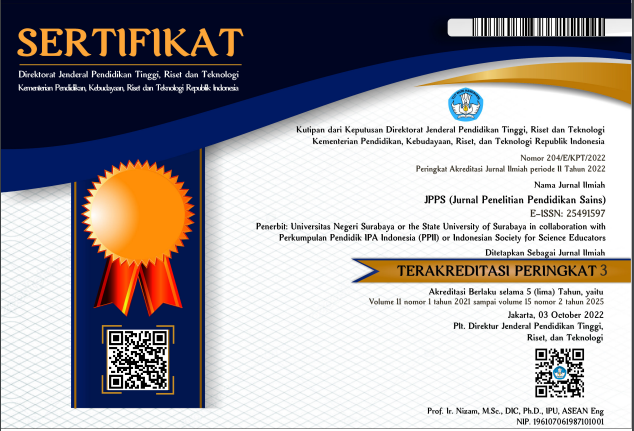EFEKTIFITAS PERANGKAT PEMBELAJARAN IPA BERORIENTASI MODEL INKUIRI UNTUK MELATIHKAN KETERAMPILAN BERPIKIR KREATIF SISWA
DOI:
https://doi.org/10.26740/jpps.v10n2.p2005-2015Kata Kunci:
Inquiry, Creative Thingking Skills, BiotechnologyAbstrak
Penelitian ini adalah penelitian pengembangan yang bertujuan mengetahui efektivitas model pembelajaran inkuiri untuk melatihkan keterampilan berpikir kreatif siswa SMP pada materi bioteknologi. Perangkat pembelajaran dengan model inkuiri untuk melatihkan keterampilan berpikir kreatif jarang tersedia, proses pembelajaran hanya berpusat pada guru saja sehingga siswa tidak aktif dikelas, padahal keaktifan siswa selama pembelajaran sangat penting karena membuat keterampilan berpikir kreatif siswa menjadi terlatih. Keterampilan berpikir kreatif merupakan skill yang penting dimiliki pada abad 21. Penerapan berpikir kreatif dalam inkuiri akan menghasilkan beragam gagasan/ ide yang bermanfaat dalam memecahkan masalah dan siswa menjadi aktif dalam pembelajaran. Jenis penelitian yang digunakan adalah penelitian deskriptif kuantitatif dengan rancangan penelitian one group pretest-posttest design. Efektifitas yang diperoleh dari uji coba terbatas untuk mendapatkan skor N-gain dan uji sensitivitas. Metode penelitian menggunakan skor N-Gain berupa adatidaknya peningkatan nilai tes keterampilan berpikir kreatif pretest ke postest pada tiap indikator keterampilan berpikir kreatif yang meliputi kelancaran, keluwesan, keaslian dan kerincian. Metode penelitian ini juga menggunakan uji sensitivitas tiap butir soal tes mengandung indikator keterampilan berpikir kreatif. Sampel yang digunakan dalam penelitian ini adalah siswa kelas IX SMP YPM 1 Taman Sidoarjo. Hasil penelitian menunjukkan adanya peningkatan nilai tes keterampilan berpikir kreatif pretes ke postes pada tiap indikator dan bernilai efektif. Sehingga dapat disimpulkan bahwa perangkat pembelajaran IPA berorientasi model inkuiri mampu melatihkan keterampilan berpikir kreatif siswa.
This research is a development research that aims todetermine the effectiveness of the inquiry learning model to train junior high school students' creative thinking skills in biotechnology chapter because learning tools with the inquiry model train creative thinking skills are not available, learning is only teacher-centered so that students are not active in class, even though student activity during learning is very important because it makes students' creative thinking skills trained. Creative thinking skills are important skills to have in the 21st century. The application of creative thinking in inquiry will generate many useful ideas in solving problems and students become active in learning. The type of research using descriptive quantitative research with a one group pretest-postest design research design. The effectiveness obtained from limited trials to obtain N-gain scores and sensitivity tests. The research method using the N-Gain score in the form of an increase in the value of the pretest to posttest creative thinking skills test on each indicator of creative thinking skills which included fluency, flexibility, originality and ellaboration. This research method also uses a sensitivity test for each test item which contains indicators of creative thinking skills. The sample using students of class IX SMP YPM 1 Taman Sidoarjo. The results showed an increase in the value of the pretest to posttest creative skills test on each indicator and was effective. So it can be ignored that the inquiry model of science learning device can train students' creative thinking skills.
Unduhan
Referensi
Aiken, Lewis R. (1997). Psychological testing and assesment (ninth edition). Boston: Allyn & Bacon.
Akbar, S. (2013). Instrumen perangkat pembelajaran. Bandung: Usaha Rosda Karya. Anam, K. (2015). Pembelajaran Berbasis Inkuiri. Yogyakarta: Pustaka Pelajar.
Anderson, L.W & Krathwohl, D.R. (2001). A taxonomy for learning, teaching, and assessing, a revision of blooms taxonomy of education objectives. New York: addisom Wesley Lonman Inc.
De Vito, A. (1989). Creative wellsprings for science teaching. West Lafayette, Indiana: Creative Venture.
Depdiknas. (2003). Undang-undang RI No.20 tahun 2003 tentang sistem pendidikan nasional. UUD 1945. Depdiknas. (2013). Model pengembangan silabus mata pelajaran dan rencana pelaksanaan pembelajaran ipa terpadu. Jakarta: Tidak diterbitkan.
Dewi, C.A & Ratna A.M. (2019). The effect of chemo-entrepreneurship oriented inquiry moduls on improving students creative thinking ability. Journal of Turkish science education, 16(2), 253-263.
Ennis, R.H. (2001). Critical thingking assesment. Journal of theory into practice, 32(3), 179- 186.
Fabian, J. (2018). Creative thinking and problem solving. London Newyork: CRC Press.
Filsaime, D.K. (2008). Menguak rahasia berpikir kritis dan kreatif. Jakarta: Prestasi Pustakaraya.
Flick, L.B & Lederman, N.G (2006). Scientific inquiry and nature of science; Impictions for teaching, learning, and teacher education IX-XVIII. USA: Springer.
Ibrahim, M. (2010). Dasar-dasar proses belajar mengajar. Surabaya: Unesa Tim Balitbang Diknas.
Kardi, S. (2013). Model Pembelajaran langsung inkuiri sains teknologi dan masyarakat. Surabaya: UNESA Pasca Sarjana Pendidikan Sains.
Kurniati, F. (2017). Pengembangan perangkat pembelajaran berbasis inkuiri terbimbing (guided inquiry) untuk meningkatkan kemampuan berpikir kreatif siswa materi sistem pernafasan pada manusia. Tesis. Program Pascasarjana Universitas Negeri Surabaya. Tidak diterbitkan.
Montuori, A. (2012). Creative Inquiry: Coonfroting the challenges of scholarship in the 21st century.
Journal of Elsivier, 4(1) 64-70. Munandar, U. (2009). Pengembangan kreativitas anak berbakat. Jakarta: Rineka cipta.
Paul, R & Elder, L. (2019). The nature and functions of critical & creative thinking. London: Rowman & Littlefield Publishers.
Qodratullah, S.T., Milla, H., & Kasmirudin. (2019). kemampuan berpikir kreatif siswa menggunakan model pembelajaran inkuiri terbimbing di SMPN 4 Bengkulu Tengah. Seminar Nasional Sains & Entrepreneurship, 1(1), 1-7.
Ratumanan, T.G & Laurens T. (2011). penilaian hasil belajar pada tingkat satuan pendidikan edisi 2. Surabaya: Unesa University press.
Riduwan. (2012). Skala Pengukuran Variabel-variabel Penelitian. Bandung: Alfabeta.
Salmon, A.K & Barrera, M.X. (2021). Intentional questioning to promote thinking & Learning. Journal of Elsevier, 40(1), 1-10.
Thuneberg, H.M., Salmi, H.S., & Bogner, F.X. (2018). How creativity, autonomy and visual reasoning contribute to cognitive learning in a STEAM hands-on inquiry-based math module. Elsevier, 29(1), 153-160.
Unduhan
Diterbitkan
Cara Mengutip
Terbitan
Bagian
Lisensi
Hak Cipta (c) 2021 JPPS (Jurnal Penelitian Pendidikan Sains)

Artikel ini berlisensi Creative Commons Attribution-NonCommercial 4.0 International License.
 Abstract views: 1091
,
Abstract views: 1091
, PDF Downloads: 1151
PDF Downloads: 1151












